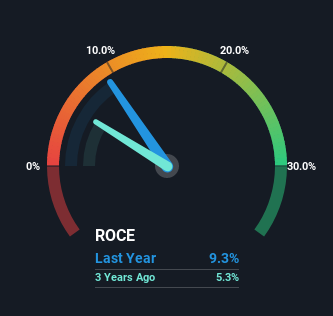AGES Industri (STO:AGES B) Hasn't Managed To Accelerate Its Returns

What trends should we look for it we want to identify stocks that can multiply in value over the long term? Ideally, a business will show two trends; firstly a growing return on capital employed (ROCE) and secondly, an increasing amount of capital employed. Basically this means that a company has profitable initiatives that it can continue to reinvest in, which is a trait of a compounding machine. Although, when we looked at AGES Industri (STO:AGES B), it didn't seem to tick all of these boxes.
Understanding Return On Capital Employed (ROCE)
For those that aren't sure what ROCE is, it measures the amount of pre-tax profits a company can generate from the capital employed in its business. To calculate this metric for AGES Industri, this is the formula:
Return on Capital Employed = Earnings Before Interest and Tax (EBIT) ÷ (Total Assets - Current Liabilities)
0.093 = kr52m ÷ (kr1.0b - kr446m) (Based on the trailing twelve months to June 2022).
Thus, AGES Industri has an ROCE of 9.3%. Ultimately, that's a low return and it under-performs the Machinery industry average of 16%.
See our latest analysis for AGES Industri

Historical performance is a great place to start when researching a stock so above you can see the gauge for AGES Industri's ROCE against it's prior returns. If you're interested in investigating AGES Industri's past further, check out this free graph of past earnings, revenue and cash flow.
What Can We Tell From AGES Industri's ROCE Trend?
Over the past five years, AGES Industri's ROCE has remained relatively flat while the business is using 21% less capital than before. When a company effectively decreases its assets base, it's not usually a sign to be optimistic on that company. Not only that, but the low returns on this capital mentioned earlier would leave most investors unimpressed.
Another point to note, we noticed the company has increased current liabilities over the last five years. This is intriguing because if current liabilities hadn't increased to 44% of total assets, this reported ROCE would probably be less than9.3% because total capital employed would be higher.The 9.3% ROCE could be even lower if current liabilities weren't 44% of total assets, because the the formula would show a larger base of total capital employed. Additionally, this high level of current liabilities isn't ideal because it means the company's suppliers (or short-term creditors) are effectively funding a large portion of the business.
The Bottom Line On AGES Industri's ROCE
Overall, we're not ecstatic to see AGES Industri reducing the amount of capital it employs in the business. And in the last five years, the stock has given away 40% so the market doesn't look too hopeful on these trends strengthening any time soon. Therefore based on the analysis done in this article, we don't think AGES Industri has the makings of a multi-bagger.
AGES Industri does come with some risks though, we found 3 warning signs in our investment analysis, and 1 of those can't be ignored...
While AGES Industri isn't earning the highest return, check out this free list of companies that are earning high returns on equity with solid balance sheets.
New: Manage All Your Stock Portfolios in One Place
We've created the ultimate portfolio companion for stock investors, and it's free.
• Connect an unlimited number of Portfolios and see your total in one currency
• Be alerted to new Warning Signs or Risks via email or mobile
• Track the Fair Value of your stocks
Have feedback on this article? Concerned about the content? Get in touch with us directly. Alternatively, email editorial-team (at) simplywallst.com.
This article by Simply Wall St is general in nature. We provide commentary based on historical data and analyst forecasts only using an unbiased methodology and our articles are not intended to be financial advice. It does not constitute a recommendation to buy or sell any stock, and does not take account of your objectives, or your financial situation. We aim to bring you long-term focused analysis driven by fundamental data. Note that our analysis may not factor in the latest price-sensitive company announcements or qualitative material. Simply Wall St has no position in any stocks mentioned.
About OM:AGES B
AGES Industri
Engages in the die casting, machining, tooling, welding, and assembly of precision components.
Flawless balance sheet and fair value.
Market Insights
Community Narratives



